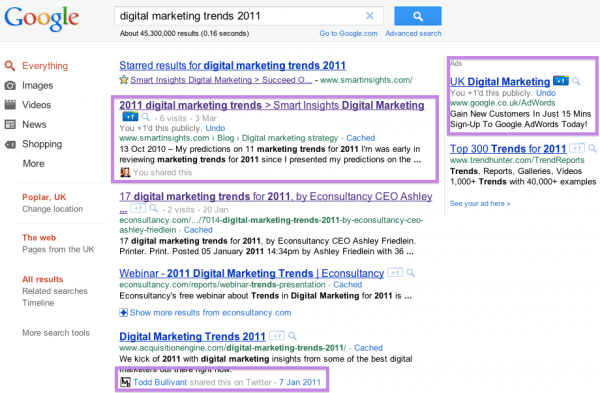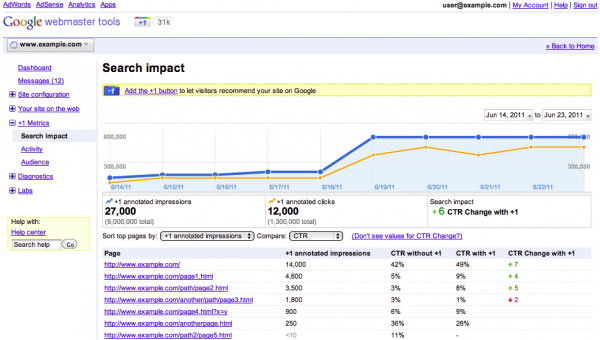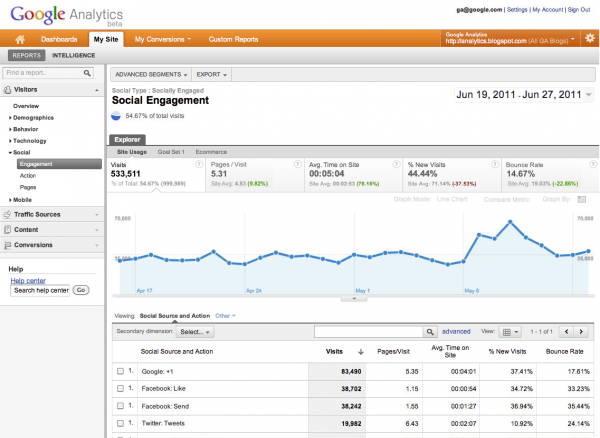We introduced Google +1 on our Google updates page back in March when this was announced, but it only became live in the UK on June 29th. So it's time to take another look and think through the implications for marketing.
June 30th update: When I originally wrote this post, I asked about methods of measuring +1 interactions, well Google were on the case and next day announced methods to measure +1s which I've linked to at the end of the post. This is a fantastic new feature in Google Analytics since it also shows Facebook and Twitter interactions - both on your site and in the network.
Google's original announcement explains how it works, but let's take a look at an example from when it went live - not many yet. You will have seen that Google has a new interface with a grey bar and a "+1" icon to the right of every paid and natural search results. When someone recommends a page (either on Google's search results page) or a site, the +1 symbol is highlighted and the name of the person sharing it is indicated. You will also have noticed that results from Twitter (but not Facebook are also shared) as shown at the bottom of the page.

Implications of Google +1 for marketing - actions to consider
We think +1 is significant for marketers since:
1. Google is using +1 recommendations as a ranking signal. Brands that encourage sharing of their home page or deeper pages will feature higher in the search results for generic searches.
2. +1 appears both in the paid and natural listings, so if your site has more recommendations it's likely to increase clickthrough rate compared to competitors who don't have it.
3. As with Facebook Likes, +1 acts as "social proof" on your site that others like your content, product and brand, so it can potentially increase conversion.
However, it's worth remembering that it only works for those who have a Google profile - I'm not sure how many use Google logged in this way.
We think the implications for marketers are:
1. You need to encourage sharing of content using +1 on your site as many sites are already - here is the native button code or consider a sharing widget like Share This.
2. Since Google+1 affects ranking it's yet another argument for investing in building a brand that encourages advocates and is readily recommendable.
3. We'll need to work out how to track the number of +1 and benchmark against competitors. We recommend you event event tracking / event goals in Google Analytics for your own +1 sharing widgets. Here's a good writeup of implementing +1 event tracking in Google Analytics. I haven't seen much written about how to tackle benchmarking of +1s - there are lots of tools for comparing Twitter likes, but none for Google +1 I'm aware of.
Measuring the impact of Google +1 interactions
Google have announced 2 additional tools that can help you measure +1 interactions. These are
1. Webmaster Tools support
A new set of menus "+1 metrics" is live now within Webmaster tools This chart shows how +1 within the SERPs is influencing CTR. This is just an example from Google - live cases will be interesting - has anyone seen any yet?

2. Google Analytics social engagement report
The new Google Analytics Beta now has a great Social Engagement report which shows different social sources giving rise to visits. You can drill down to see pages viewed and actions taken. To set this up you need to follow this "Social tagging Social Interaction tracking approach. This show how Google Analytics has setup interfaces to both Twitter and Facebook APIs so that actions like Facebook Likes and Tweets can be recorded and viewed within Google Analytics. Neat! This will really help reduce the need for separate social interaction tracking tools. This is big news if you're managing social media marketing, but seems it was lost amongst among the Google+ announcement! Again I'm interested in stories of how you get on with this feature. We're relaunching our site soon, so other priorities for now.










